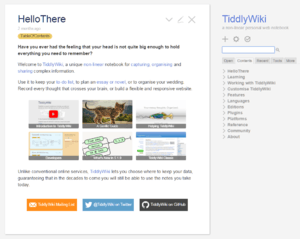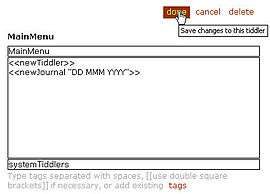TiddlyWiki
TiddlyWiki is a personal wiki and a non-linear notebook for organising and sharing complex information. It is an open-source single page application wiki in the form of a single HTML file that includes CSS, JavaScript, and the content. It is designed to be easy to customize and re-shape depending on application. It facilitates re-use of content by dividing it into small pieces called Tiddlers.
 | |
 Screenshot of TiddlyWiki | |
| Developer(s) | Jeremy Ruston and community members |
|---|---|
| Initial release | 30 September 2004 |
| Stable release | |
| Repository | |
| Operating system | Cross-platform |
| Available in | Multilingual, over 20 languages in TiddlyWiki 5.1.21.[2] |
| Type | Wiki |
| License | BSD license |
| Website | tiddlywiki |

Applications
TiddlyWiki is designed for customization and to be shaped according to users' specific needs, perhaps comparable to a high-end programming language. As such, it can be shaped into a wide and arbitrary range of special applications. Examples include niche note taking applications, to-do lists, presentations, collections, authoring tools, personal databases, recipe collections, etc.
Although there are many TiddlyWiki documents on the Web,[3][4] the majority of TiddlyWikis reside on personal computers or in the cloud, or are exchanged over email, in a manner similar to word processing documents and spreadsheets. As a single HTML file, or saved as an HTA file in Microsoft Windows (allowing corporate IE lockdown to be bypassed), TiddlyWiki can be useful in corporate environments where red tape or IT resources might prevent the use of a wiki that requires a more complicated installation.[5]
TiddlyWiki has been used as a software framework to build specialisations. For example ...
- Interactive Historical Atlas of the Disciplines â University of Geneva is an Interactive Historical Atlas of the (Knowledge) Disciplines
- SocialText uses TiddlyWiki as a part of their unplugged feature.[6]
Tiddlers
TiddlyWiki introduces the division of content into its "smallest, semantically meaningful, components", referred to as tiddlers. Each tiddler is stored inside an HTML division that contains the source text and meta data in wiki markup. The purpose with this division is to enable easy re-use of content for different narratives and in different contexts.
For example, this section ("Tiddlers") could be a tiddler. In the TiddlyWiki user interface it would appear as it appears here but as a separate "note" visually distinct from other tiddlers.
The underlying HTML source code (which is not what the user faces) would be something like:
<div title="Tiddlers"
modifier="John Smith"
created="200811132220"
modified="200811132225"
changecount="3"
tags="Wikipedia section example code">
<pre>TiddlyWiki introduces the division of...
This same "tiddler" could then be reused in other contexts in the wiki.
Plugins
In addition to containing text, a tiddler can be a plugin with additional JavaScript and CSS to extend TiddlyWiki. As a result, TiddlyWiki is used in a wide variety of adaptations and uses beyond that of a personal wiki. One example is for interactive graph visualization or mind-maps with the plugin TiddlyMap.[7][8]
Community
There is an active, helpful and growing community of TiddlyWiki enthusiasts at Google Groups
File saving
TiddlyWiki may be saved as a single html file containing both the data (tiddlers) and the application (wiki), or the data can be saved on a per tiddler basis in text files (via extensions).
A TiddlyWiki opened from a file URI may save changes made back to the original file using one of the following techniques:
- the Microsoft ActiveX FileSystemObject [9] for Internet Explorer
- TiddlySaver Java applet to extend Safari, Opera, Chrome/Chromium, and other browsers. Requires the Java runtime.
- Two techniques were developed for the Firefox browser:
- Mozilla File I/O [10] under the control of the UniversalXPConnect per-file preferences.[11] That functionality was removed from Firefox.
- The TiddlyFox add-on for Firefox uses the Firefox SDK's simple-storage API. The add-on stopped working with Firefox around version 57 in 2017 which does not support the API.[12]
History
- The first version of TiddlyWiki was released by Jeremy Ruston in September 2004.[13]
- BT Group bought Osmosoft in 2007[14][15] appointing Ruston as BT's "Head of Open Source Innovation".[16]
- TiddlyWiki was selected as one of the Top 100 Tools for 2007 and 2008 by the Centre for Learning & Performance Technologies.[17]
- In November 2011, Jeremy Ruston announced his departure from Osmosoft and commitment to continue development on TiddlyWiki.[18][19]
- In December 2013 TiddlyWiki5 was released. It is a total rebuild of the original TiddlyWiki, based on HTML5 and with many significant improvements from lessons learnt over the years with the original TiddlyWiki. The original TiddlyWiki has come to be called TiddlyWiki Classic.[20]
License
TiddlyWiki is free and open source software and is distributed under the terms of the BSD license.[21]
The copyright of TiddlyWiki is held in trust by UnaMesa,[22] a non-profit organization.
See also
| Wikimedia Commons has media related to TiddlyWiki. |
- Single page application
- Personal wiki
- Project Xanadu
- List of wiki software
- Comparison of wiki software
- Comparison of notetaking software
References
- "Jermolene/TiddlyWiki5". github.com. Retrieved 2019-03-17.
- "TiddlyWiki Translations". TiddlyWiki Trac Wiki. TiddlyWiki Development team. 2004–2015. Archived from the original on January 24, 2015. Retrieved 20 January 2011.
- "TiddlyWiki — a non-linear personal web notebook". tiddlywiki.com. Retrieved 2018-08-24.
- "TiddlyWiki toolmap - Dynalist". dynalist.io. Retrieved 2018-08-24.
- "Guerilla wiki". Tech Writer Wiki. Retrieved 11 February 2012.
- "TiddlyWiki - a reusable non-linear personal web notebook". W3.org. 2008-01-01. Retrieved 2012-05-23.
- "TiddlyWiki — a non-linear personal web notebook". tiddlywiki.com. Retrieved 2018-08-24.
- "TiddlyMap - Wiki-Based Concept-Mapping Software". TiddlyMap.org. 2018-08-24.
- "FileSystemObject Basics". MSDN. Microsoft. Retrieved 2012-05-23.
- "File I/O - MDN". Developer.mozilla.org. 2012-03-31. Retrieved 2012-05-23.
- Stoltz, Mitch. "Per-File Permissions". Mozilla.org. Retrieved 2012-05-23.
- "Add-ons - simple-storage". MDN Web Docs. Mozilla.org. 2017-01-14. Retrieved 2017-10-20.
Starting from Firefox 57, only extensions developed using WebExtensions APIs will be supported on Desktop Firefox and Firefox for Android.
- "TiddlyWiki a reusable non-linear personal web notebook".
- jermolene (May 29, 2007). "I For One Welcome My New BT Overlords". Treat with Jermolene. Archived from the original on 2011-08-18.
- "Telco 2.0: BT Tries To Fix Global Services with Open Source". Telco2.net. Retrieved 2012-05-23.
- "Open Source Will Change Enterprises, Says BT Guru". TechWeekEurope UK. Eweekeurope.co.uk. 2009-10-16. Archived from the original on 2010-02-28. Retrieved 2012-05-23.
- Hart, Jane (13 August 2011). "Top Tools: Tiddlywiki". Centre for Learning & Performance Technologies. Archived from the original on 2011-12-08. Retrieved February 2, 2017.
- "On Leaving BT and Osmosoft - TiddlyWiki | Google Groups". Retrieved 2012-05-23.
- Rejali, Cameron. "Jeremy Ruston to leave BT". Osmosoft. Archived from the original on 2005-04-19.
- "TiddlyWiki — a non-linear personal web notebook". tiddlywiki.com. Retrieved Jun 24, 2020.
- "TiddlyWiki — a non-linear personal web notebook". tiddlywiki.com. Retrieved Jun 24, 2020.
- "UnaMesa Association". unamesa.org. Retrieved 2018-08-24.